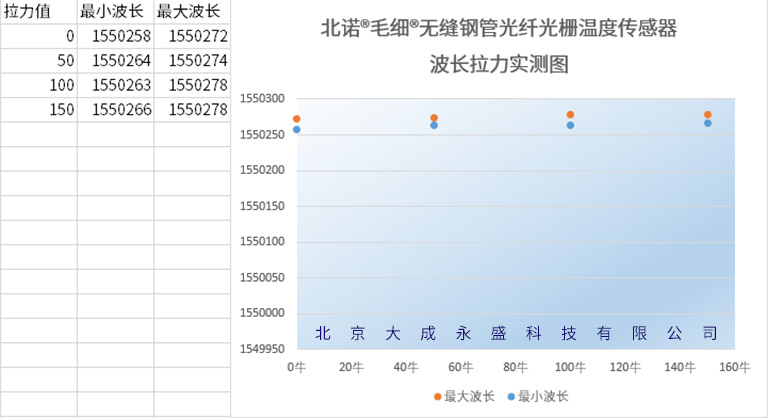Fiber Bragg Grating Sensing Technology Encyclopedia - FBG FAQ - FBG Sensor FAQ - FBG Demodulator FAQ - FBG Common Application Problem Analysis
Experiment Ⅰof Fiber Bragg Grating(FBG) Temperature Sensor - Influence of Tensile Force, Stress, and Strain on FBG Thermometer
DCYS is a professional manufacturer of fiber bragg grating temperature sensors with accurate temperature measurement. It provides information such as test and verification methods, verification experiments, and test reports for accurate temperature measurement of FBG temperature sensors. The brand of FBG temperature sensors with accurate temperature measurement is "OFSCN".
In this article, we conducted a tensile experiment on OFSCN® Capillary Seamless Steel Tube Fiber Bragg Grating temperature sensors (FBG thermometers). The experiment tested the temperature-wavelength relationship of the fiber Bragg grating (FBG) under different tensile conditions.
Through the experimental report and error analysis, we demonstrated that OFSCN® Capillary Seamless Steel Tube temperature sensors (FBG thermometers) produced by OFSCN overcome the inherent drawbacks of FBG sensors (temperature and strain/stress cross-sensitivity) and exhibit accuracy and high precision in practical use.
In a previous article titled "Drawbacks and Force Analysis of Traditional Fiber Bragg Grating Temperature Sensors (FBG Thermometers) - Reasons for Inaccurate Temperature Measurement", we analyzed the three forces that the fiber Bragg grating (FBG) in traditional FBG sensors may experience. In the new OFSCN® Capillary Seamless Steel Tube Fiber Bragg Grating temperature sensors (FBG thermometers), the FBG remains completely free from any external forces.
To prove this point, we are conducting the first experiment, "Tensile Experiment." The following is the experimental report and data analysis:
 |
|
Figure 1 |
|
|
| Figure 2 |
Ⅰ. Experiment Objective
To verify that OFSCN® Capillary Seamless Steel Tube temperature sensors (FBG thermometers) produced by DCYS are minimally affected by external forces during construction and use, and that the fiber Bragg grating (FBG) inside the sensors does not experience stress or strain.
Ⅱ. Experimental Equipment
Fiber Bragg grating demodulator, OFSCN® Capillary Seamless Steel Tube Fiber Bragg Grating temperature sensor (FBG thermometer), tensile gauge, mercury thermometer, temperature-controlled chamber.
Ⅲ. Experimental Method
In this experiment, an OFSCN® Capillary Seamless Steel Tube Fiber Bragg Grating temperature sensor (FBG thermometer) was connected to a fiber Bragg grating demodulator. The sensor was clamped and fixed using a fixture near the fiber junction, and a tensile gauge was attached to the rear end of the sensor using another fixture. The sensing part of the sensor, which includes the fiber Bragg grating (FBG), was placed inside the temperature-controlled chamber.
Under different tensile conditions, the fiber Bragg grating (FBG) wavelength in the OFSCN® Capillary Seamless Steel Tube Fiber Bragg Grating temperature sensor (FBG temperature sensor) was read using the fiber Bragg grating demodulator. The experiment was completed after comparison.
Ⅳ. Experimental Procedure and Data Analysis
Since the wavelength of the fiber Bragg grating (FBG) is related to the ambient temperature and the applied tensile force, the experimental procedure needed to consider temperature variations. The experiment first collected the temperature inside the temperature-controlled chamber, which fluctuated between 52.5 and 53.1 degrees Celsius. At this temperature, the center wavelength of the NO.3 OFSCN® Capillary Seamless Steel Tube Fiber Bragg Grating temperature sensor (FBG thermometer) was recorded in its natural state, with a wavelength range of 1550258 to 1550272.
A tensile force of 50 Newtons was applied, and after a 10-minute rest to eliminate the influence of manual operations, the center wavelength of the NO.3 OFSCN® Capillary Seamless Steel Tube Fiber Bragg Grating temperature sensor (FBG thermometer) was recorded, with a wavelength range of 1550264 to 1550274.
A tensile force of 100 Newtons was applied, and after a 10-minute rest to eliminate the influence of manual operations, the center wavelength of the NO.3 OFSCN® Capillary Seamless Steel Tube Fiber Bragg Grating temperature sensor (FBG thermometer) was recorded, with a wavelength range of 1550263 to 1550278.
A tensile force of 150 Newtons was applied, and after a 10-minute rest to eliminate the influence of manual operations, the center wavelength of the NO.3 OFSCN® Capillary Seamless Steel Tube Fiber Bragg Grating temperature sensor (FBG thermometer) was recorded, with a wavelength range of 1550266 to 1550278.
The complete set of experimental data analysis is shown in Figure 1.
 |
|
Figure 3 |
Ⅴ. Experimental Conclusion
Based on the above experimental data, it can be concluded that OFSCN® Capillary Seamless Steel Tube Fiber Bragg Grating temperature sensors (fiber Bragg grating temperature sensors) produced by DCYS are minimally affected by external forces during construction and use. Regardless of how the external tensile force changes, the force acts on the seamless steel tube used in the sensor, and the fiber Bragg grating (FBG) inside the sensor does not experience stress or strain. This effectively solves the technical challenge of temperature and strain/stress cross-sensitivity in traditional fiber Bragg grating sensors (FBG sensors).
Our philosophy is: "OFSCN®, make optical fiber stronger!"

